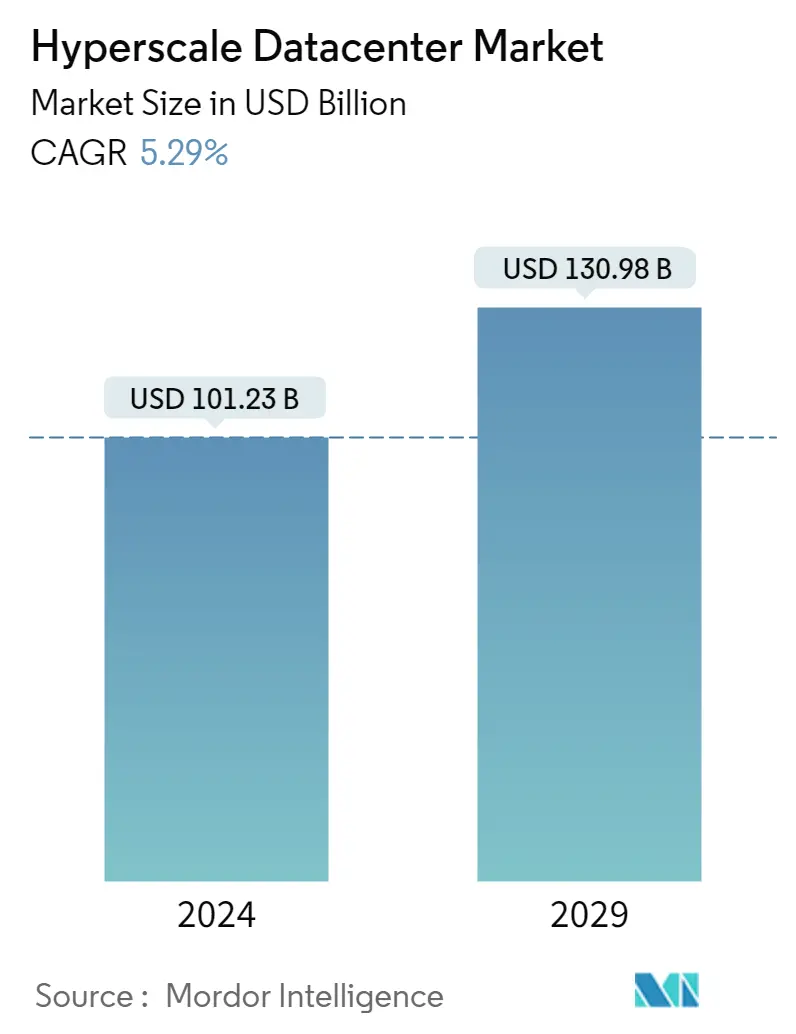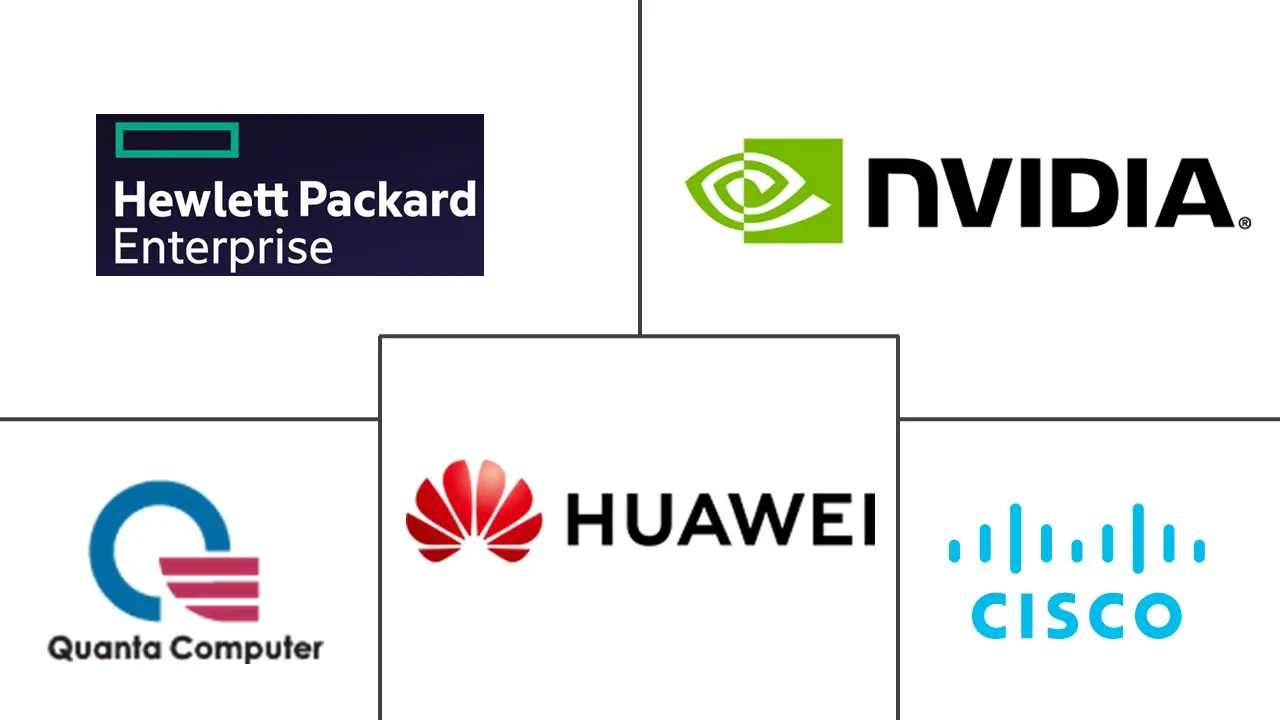Market Size of Hyperscale Datacenter Industry

| Study Period | 2019 - 2029 |
| Market Size (2024) | USD 101.23 Billion |
| Market Size (2029) | USD 130.98 Billion |
| CAGR (2024 - 2029) | 5.29 % |
| Fastest Growing Market | North America |
| Largest Market | Europe |
Major Players
*Disclaimer: Major Players sorted in no particular order |
Hyperscale Data Center Market Analysis
The Hyperscale Datacenter Market size is estimated at USD 101.23 billion in 2024, and is expected to reach USD 130.98 billion by 2029, growing at a CAGR of 5.29% during the forecast period (2024-2029).
Hyperscale data centers have become highly powerful in recent years due to the increased computing and storage requirements to serve high-end applications. Business-critical apps are increasing, resulting in greater data center complexity. With the rising popularity of the web, e-commerce, social media, big data, computing, online gaming hosting, and Hadoop, the infrastructure needs to improve application speed, energy efficiency, and server density are increasing.
- In the recent past, data was considered the foundation of an emerging economy. Almost all enterprises use more data than before and will probably consume even more data in the future. This rapidly increasing data generation must be stored and accessed from somewhere. According to Cisco Systems, the global IP data traffic increased from 96,054 petabytes per month in 2016 to 150,910 petabytes per month in 2018, and it reached 278,108 petabytes per month last year.
- Moreover, the rising demand for over-the-top (OTT) applications through an app or service that can be availed over the internet bypass traditional distribution practices. Services available for over-the-top services are significantly related to the media and communication sector, which can be accessed at a lower cost and contributes to massive data growth, thereby driving the market.
- Furthermore, owing to the rapidly increasing adoption of IoT, cloud, and Big Data, analytics across multiple enterprises as a part of their digital transformation strategy, the burden on the data centers is also increasing, leading to growth in the hyperscale data centers globally.
- Enterprises that offer large cloud services, e-commerce, advanced research of pharmaceuticals, oil and gas, aerospace, stock exchange, and others have invested in the network infrastructure they require. However, sourcing security solutions to meet these needs presents a challenge since existing next-generation firewalls (NGFWs) still need to meet the massive scale and performance needs of hyperscale architectures.
- With the recent outbreak of COVID-19 worldwide, the demand for the data center is bifurcated with strong buying by hyperscale companies and cloud platforms. In contrast, there was a slowdown in spending by many enterprise users. Pandemic-driven leasing activity was concentrated in significant cloud markets. After the pandemic, the market is growing rapidly with the increased adoption of digitization and enterprises moving toward hybrid and remote working models.
Hyperscale Data Center Industry Segmentation
A data center can support hundreds of physical servers in it and several thousands of virtual machines. A hyperscale facility is made to support thousands of physical servers incorporating millions of virtual machines. These data centers offer robust, scalable applications, and a portfolio of services to individual consumers and businesses. As hyperscale computing is becoming more necessary for cloud and Big Data storage, the market is set to witness robust growth.
Factors driving and challenging the development of hyperscale data centers have been analyzed as a part of the study.
Major Hyperscale data center providers, especially FAMG are discussed in detail in the study. The report also covers how the recent outbreak of the pandemic affected the companies' operations overall and in terms of data center planning and construction activities.
The market sizes and forecasts are provided in terms of value (USD billion) for all the above segments.
| By End User | |
| Enterprises | |
| Colocation Providers |
| By Country | |
| United States | |
| Canada | |
| China | |
| Japan | |
| Australia | |
| United Kingdom | |
| Germany | |
| Other Countries |
Hyperscale Datacenter Market Size Summary
The hyperscale data center market is experiencing significant growth, driven by the increasing demand for robust computing and storage solutions to support high-end applications. As businesses rely more on data-intensive applications such as e-commerce, social media, and big data analytics, the complexity and scale of data centers have expanded. This growth is further fueled by the rising adoption of cloud computing, IoT, and digital transformation strategies across various industries. The shift towards cloud-based solutions is particularly notable, as enterprises seek to reduce costs and enhance efficiency by migrating from on-premise infrastructure to cloud services. The COVID-19 pandemic has accelerated this trend, with a surge in demand for cloud services and remote access solutions, as organizations adapt to hybrid and remote working models.
The market landscape is moderately fragmented, with both global players and smaller enterprises competing for market share. Key players are leveraging strategies such as partnerships and acquisitions to enhance their offerings and maintain a competitive edge. The demand for hyperscale data centers is also growing in regions like Southeast Asia and Europe, where investments in cloud infrastructure and digital services are on the rise. Notable developments include the expansion of data center facilities by major companies like NTT Ltd and Google, as well as the construction of new campuses in strategic locations. These developments underscore the critical role of hyperscale data centers in supporting the burgeoning digital economy and the increasing need for scalable, efficient, and secure data storage solutions.
Hyperscale Datacenter Market Size - Table of Contents
-
1. MARKET INSIGHTS
-
1.1 Market Overview
-
1.2 Industry Attractiveness - Porter's Five Force Analysis
-
1.2.1 Bargaining Power of Suppliers
-
1.2.2 Bargaining Power of Consumers
-
1.2.3 Threat of New Entrants
-
1.2.4 Intensity of Competitive Rivalry
-
1.2.5 Threat of Substitute Products
-
-
1.3 Industry Value Chain Analysis
-
1.4 Technology Snapshot
-
1.5 Assessment of the Impact of COVID-19 on the Market
-
-
2. MARKET SEGMENTATION
-
2.1 By End User
-
2.1.1 Enterprises
-
2.1.2 Colocation Providers
-
-
2.2 By Country
-
2.2.1 United States
-
2.2.2 Canada
-
2.2.3 China
-
2.2.4 Japan
-
2.2.5 Australia
-
2.2.6 United Kingdom
-
2.2.7 Germany
-
2.2.8 Other Countries
-
-
Hyperscale Datacenter Market Size FAQs
How big is the Hyperscale Datacenter Market?
The Hyperscale Datacenter Market size is expected to reach USD 101.23 billion in 2024 and grow at a CAGR of 5.29% to reach USD 130.98 billion by 2029.
What is the current Hyperscale Datacenter Market size?
In 2024, the Hyperscale Datacenter Market size is expected to reach USD 101.23 billion.

